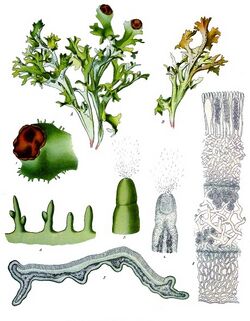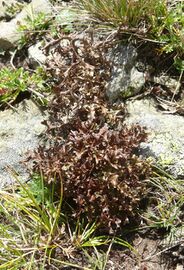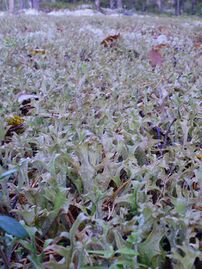Biology:Cetraria islandica
| Iceland moss | |
|---|---|

| |
| Scientific classification | |
| Domain: | Eukaryota |
| Kingdom: | Fungi |
| Division: | Ascomycota |
| Class: | Lecanoromycetes |
| Order: | Lecanorales |
| Family: | Parmeliaceae |
| Genus: | Cetraria |
| Species: | C. islandica
|
| Binomial name | |
| Cetraria islandica (L.) Ach. (1802)
| |
| Synonyms | |
| |
Cetraria islandica, also known as true Iceland lichen[1] or Iceland moss, is an Arctic-alpine lichen whose erect or upright, leaflike habit gives it the appearance of a moss, where its name likely comes from.
Description
It is often of a pale chestnut color, but varies considerably, being sometimes almost entirely grayish-white; and grows to a height of from 7.6 to 10.2 centimetres (3 to 4 inches), the branches being channelled or rolled into tubes, which end in flattened lobes with fringed edges.[2][3]
Chemistry
In commerce it is a light-gray harsh cartilaginous body, almost colorless, and tastes slightly bitter. It contains about 70% of lichenin or lichen-starch, a polymeric carbohydrate compound isomeric with common starch. It also yields a peculiar modification of chlorophyll (called thallochlor), fumaric acid, lichenostearic acid, and cetraric acid (which gives it the bitter taste). It also contains lichesterinic acid and protolichesterinic acids.[2]
Distribution and habitat
It grows abundantly in the mountainous regions of northern countries, and it is specially characteristic of the lava slopes and plains of the west and north of Iceland. It is found on the mountains of north Wales, northern England , Scotland and south-west Ireland.[2] In North America its range extends through Arctic regions, from Alaska to Newfoundland, and south in the Rocky Mountains to Colorado, and to the Appalachian Mountains of New England.[3]
Ecology
Cetraria islandica is a known host to the lichenicolous fungus species Lichenopeltella cetrariicola, which is known from Europe and Iceland.[4]
Uses
All parts of the lichen are edible. It may be dry in winter but can be soaked. Boiling removes the plant's bitterness. It can be added as a thickener to milk or grains or dried and stored.[5]
It is not in great demand, and even in Iceland it is only occasionally used to make folk medicines[6] and in a few traditional dishes. In earlier times, it was much more widely used in breads, porridges, soups, etc.[7] It forms a nutritious and easily digested amylaceous food, being used in place of starch in some preparations of hot chocolate.[citation needed] Cetraric acid or cetrarin, a white micro-crystalline powder with a bitter taste, is readily soluble in alcohol, and slightly soluble in water and ether.[2] It has been recommended for medicinal use by alternative medicine sites, in doses of 2 to 4 grains (0.1 to 0.25 grams), as a bitter tonic and aperient.[2] It is traditionally used to relieve chest ailments,[8][better source needed] irritation of the oral and pharyngeal mucous membranes and to suppress dry cough.[9]
Gallery
References
- ↑ "Standardized Common Names for Wild Species in Canada". 2020. https://www.wildspecies.ca.
- ↑ 2.0 2.1 2.2 2.3 2.4 (Chisholm 1911)
- ↑ 3.0 3.1 Angier, Bradford (1974). Field Guide to Edible Wild Plants. Stackpole Books. p. 106. ISBN 978-0-8117-2018-2. https://books.google.com/books?id=Z8TqkPYXOR4C&pg=PA106.
- ↑ 4.0 4.1 Svane, Svanhildur Jónsdóttir; Alstrup, Vagn (2004). "Some lichenicolous fungi from Iceland". Acta Botanica Islandica 14: 53–58. https://utgafa.ni.is/Acta-Botanica-Islandica/Acta-Botanica-Islandica-14/Acta-Botanica-Islandica-14-2.pdf.
- ↑ (in en-US) The Complete Guide to Edible Wild Plants. United States Department of the Army. New York: Skyhorse Publishing. 2009. pp. 61. ISBN 978-1-60239-692-0. OCLC 277203364. https://www.worldcat.org/oclc/277203364.
- ↑ Cetraria islandica at Plants for the Future
- ↑ Iceland Recipe
- ↑ Iceland Moss
- ↑ "Assessment report on Cetraria islandica (L.) Acharius s.l., thallus". European Medicines Agency. https://www.ema.europa.eu/en/documents/herbal-report/final-assessment-report-cetraria-islandica-l-acharius-sl-thallus-first-version_en.pdf. Retrieved 2024-01-07.
External links
Wikidata ☰ Q582664 entry
 |







